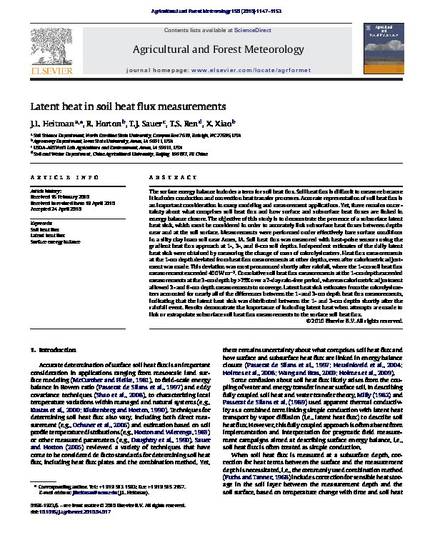
The surface energy balance includes a term for soil heat flux. Soil heat flux is difficult to measure because it includes conduction and convection heat transfer processes. Accurate representation of soil heat flux is an important consideration in many modeling and measurement applications. Yet, there remains uncertainty about what comprises soil heat flux and how surface and subsurface heat fluxes are linked in energy balance closure. The objective of this study is to demonstrate the presence of a subsurface latent heat sink, which must be considered in order to accurately link subsurface heat fluxes between depths near and at the soil surface. Measurements were performed under effectively bare surface conditions in a silty clay loam soil near Ames, IA. Soil heat flux was measured with heat-pulse sensors using the gradient heat flux approach at 1-, 3-, and 6-cm soil depths. Independent estimates of the daily latent heat sink were obtained by measuring the change of mass of microlysimeters. Heat flux measurements at the 1-cm depth deviated from heat flux measurements at other depths, even after calorimetric adjustment was made. This deviation was most pronounced shortly after rainfall, where the 1-cm soil heat flux measurement exceeded 400 W m−2. Cumulative soil heat flux measurements at the 1-cm depth exceeded measurements at the 3-cm depth by >75% over a 7-day rain-free period, whereas calorimetric adjustment allowed 3- and 6-cm depth measurements to converge. Latent heat sink estimates from the microlysimeters accounted for nearly all of the differences between the 1- and 3-cm depth heat flux measurements, indicating that the latent heat sink was distributed between the 1- and 3-cm depths shortly after the rainfall event. Results demonstrate the importance of including latent heat when attempts are made to link or extrapolate subsurface soil heat flux measurements to the surface soil heat flux.
Available at: http://works.bepress.com/robert-horton/60/

This article is published as Heitman, J. L., Robert Horton, T. J. Sauer, T. S. Ren, and Xinhua Xiao. "Latent heat in soil heat flux measurements." Agricultural and forest meteorology 150, no. 7 (2010): 1147-1153. doi: 10.1016/j.agrformet.2010.04.017. Posted with permission.